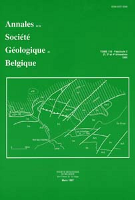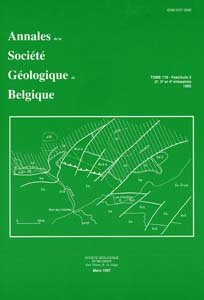- Accueil
- Volume 107 (1984)
- Volume complet
- The granitic rocks and the development of the continental crust
Visualisation(s): 381 (3 ULiège)
Téléchargement(s): 994 (12 ULiège)
The granitic rocks and the development of the continental crust

Résumé
L'origine des granites a depuis longtemps fait l'objet de discussions controversées parmi les géologues, quant à leur région-source, à leur origine et à leur mode d'évolution. De nombreuses classifications en ont résulté.
La complexité pétrogénétique des granites est illustrée dans ce travail à partir de trois exemples de massifs situés dans des contextes géotectoniques totalement différents :
1. Les enclaves plutoniques (gabbro -> granite alcalin) dans les laves de l'île de l'Ascension reflètent la possibilité de générer de petits volumes de roches acides en milieu océanique par différenciation de magma basique.
2. Les granites alcalins de l'Archipel des Seychelles (Océan indien) proviennent de la différenciation d'un magma mantélique qui a néanmoins incorporé du matériel de la croûte continentale supérieure dans une proportion relativement faible, reflétant la situation géotectonique du complexe : un bombement épeirogénique antérieur à une fragmentation continentale.
3. Les roches acides charnockitiques associées aux complexes anorthositiques du Rogaland (Norvège méridionale) correspondent au liquide résiduel de la différenciation des anorthosites fortement contaminé par du matériel de la croûte inférieure (faciès granulite) lors du développement orogénique.
Abstract
Granites have been subject to many controversies with respect to their source, mode of origin, subsequent evolution and, consequently, with regard to their classification. Indeed, the nomenclature of granites s.l. depends on the criteria used to classify these rocks : chemical composition (aluminous, calc-alkaline or alkaline granites) and/or geotectonic situation (orogenic versus anorogenic granites). These controversies reflect primarily the multiplicity of processes generating granitic rocks but also the intimate interdependance between the scientific approach and the researcher's ideas.
To illustrate the complexity of granite petrogenesis, different examples are studied.
1. The possibility of generating small volumes of acidic rocks in an oceanic environment has recently been demonstrated for the Kerguelen syenitic-granitic ring complexes (Dosso et al., 1979 ; Dosso & Murphy, 1980) and for the alkaline acidic plutonic enclaves in the Ascension island lavas. In both cases, continental contamination is obviously absent as is confirmed by the Pb, Sr and Nd isotope compositions. These granitic differentiates could be considered as "sialic nuclei" constituting a picture of a first proto-continental stage.
2. The main islands of the Seychelles Archipelago (Indian Ocean) are mainly composed of granitic rocks of Precambrian age ranging in composition from a biotite-hornblende type to a slightly alkaline type. More basic rocks, of gabbroic to dioritic composition, occur only as dark fine-grained enclaves. Both petrography and trace element geochemistry indicate the alkaline character of these granites and also show that the different facies could belong to a single magmatic differentiation suite. Pb isotope compositions of whole rock samples and K-feldspars point to a mantle origin for the parental magma but indicate, on the basis of the relatively high 207Pb/204 Pb ratios, that these rocks have been slightly contaminated by upper crustal material. This interpretation is compatible with Sr initial isotopic compositions and with the initial eBE values. The process of interaction between mantle derived magma Nd and the continental crust was not very important which could reflect the geotectonic situation, namely epeirogenic doming prior to continental break-up. In contrast with the active processes of oceanic crust genesis, this kind of neoformed granites could contribute by means of a pulsing accretion processes to a more extensive continental crust.
3. Granitic rocks of orogenic zones, on the contrary, may be entirely generated by the reworking of crustal material, i.e. muscovite leucogranites (Didier & Lameyre, 1969) or S-type granites (Chappelland White, 1971). Nevertheless, in the deep continental crust, large volumes of mantle derived basic rocks of anorthositic-gabbroic composition contribute to an increased crustal volume. Acidic rocks of charnockitic type are commonly associated with anortho-sites : these correspond to the residual liquid of the anorthosite differentiation which is contaminated to a major degree by material from the granulite facies of the lower crust during the deformation process (De Waard et al., 1974 ; Duchesne & Demaiffe, 1978 ; Demaiffe & Hertogen, 1981).
Pour citer cet article
A propos de : Jean Michot
Laboratoires Associés de Géologie-Pétrologie-Géochronologie. Université Libre de Bruxelles. Avenue F.D. Roosevelt, 50 - B 1050 Bruxelles - Belgium.
A propos de : Dominique Weis
Laboratoires Associés de Géologie-Pétrologie-Géochronologie. Université Libre de Bruxelles. Avenue F.D. Roosevelt, 50 - B 1050 Bruxelles - Belgium.
A propos de : Daniel Demaiffe
Laboratoires Associés de Géologie-Pétrologie-Géochronologie. Université Libre de Bruxelles. Avenue F.D. Roosevelt, 50 - B 1050 Bruxelles - Belgium.





